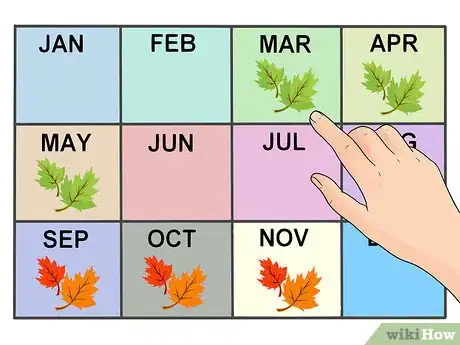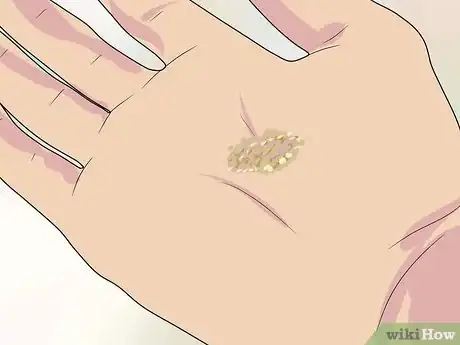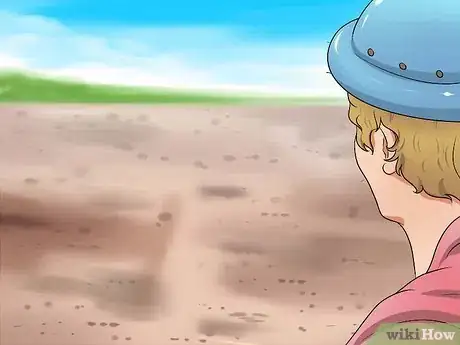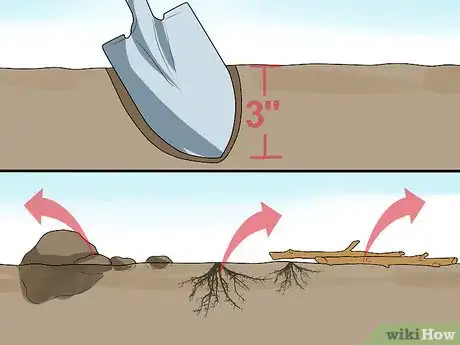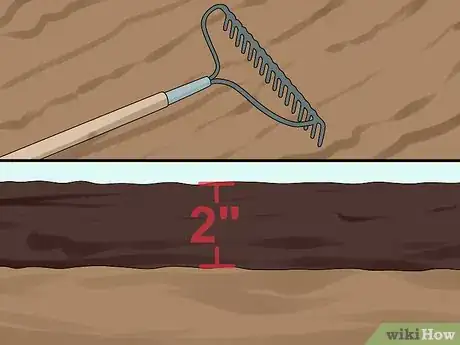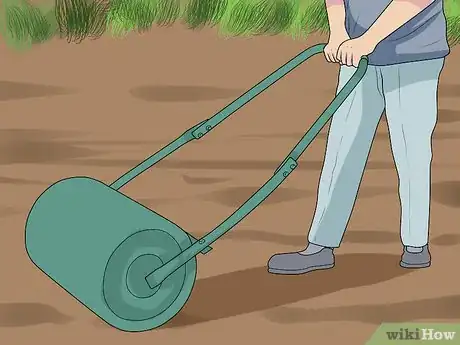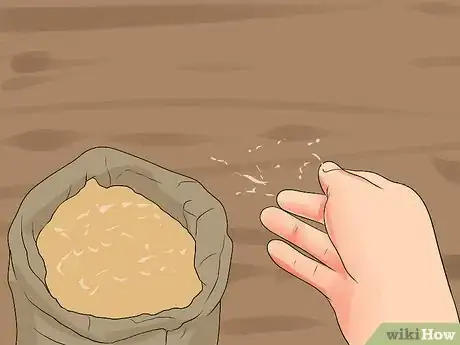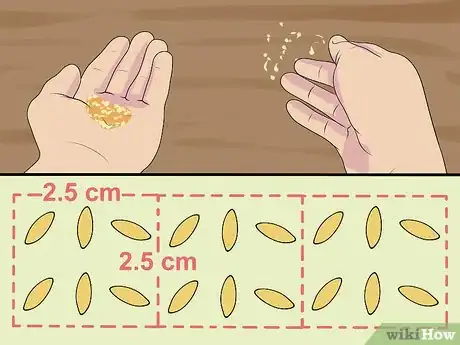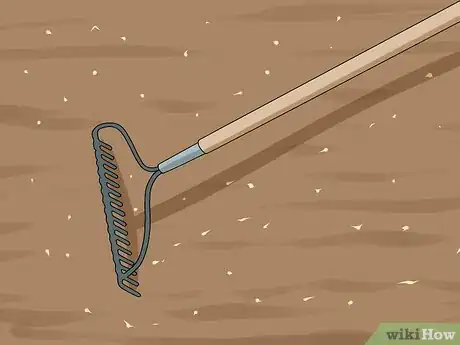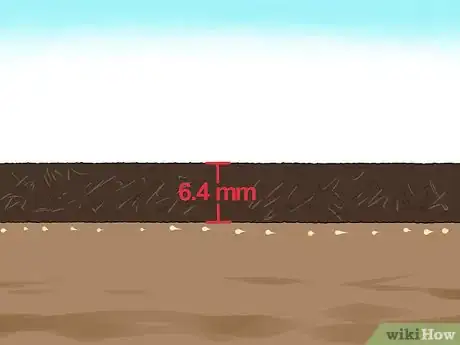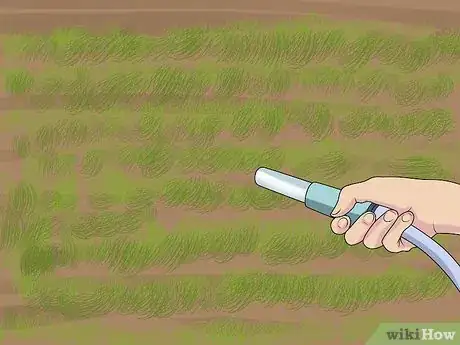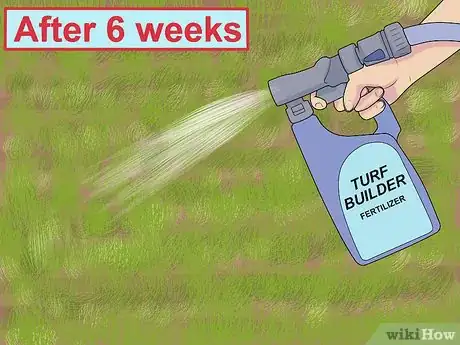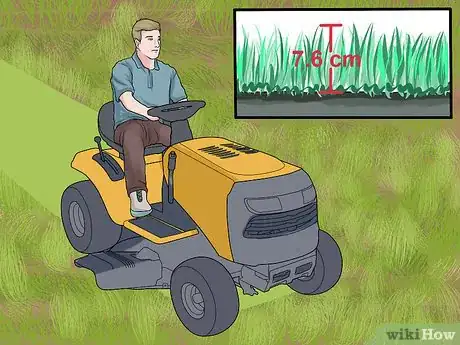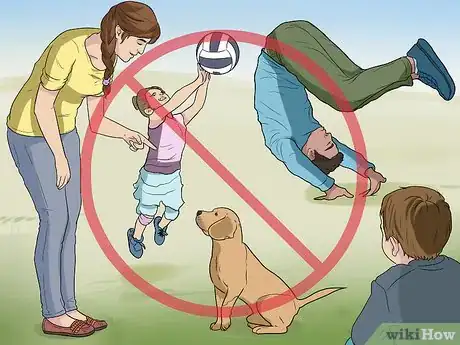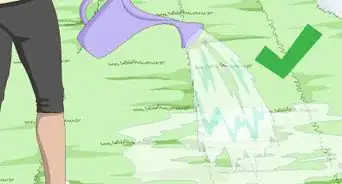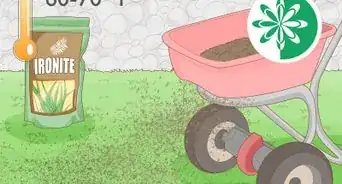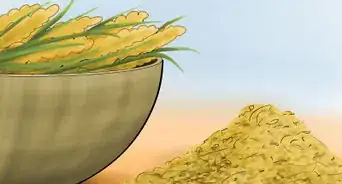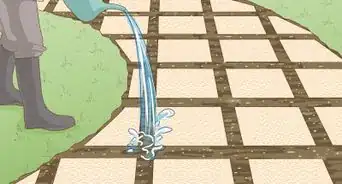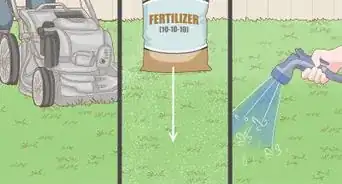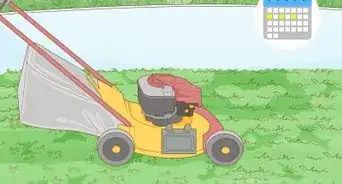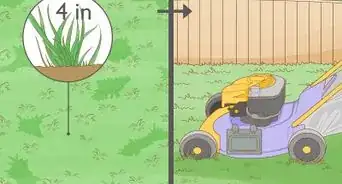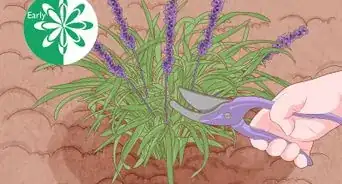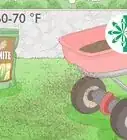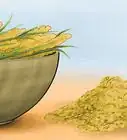This article was co-authored by Katie Gohmann. Katherine Gohmann is a Professional Gardener in Texas. She has been a home gardener and professional gardener since 2008.
There are 7 references cited in this article, which can be found at the bottom of the page.
This article has been viewed 126,762 times.
Grass is a great way to add life to your yard, it gives kids and pets a soft and comfortable place to play, and it can make your property look more tended and cared for. There are many ways to grow new grass in your yard, but growing it from seed is one of the most cost-effective methods out there. The major steps involved with sowing grass seed include picking the right type of grass, tilling and preparing the soil, planting the seeds, and covering the newly sown seeds with mulch.
Steps
Getting the Lawn Ready
-
1Choose the right time of year. The best times of year to plant grass are in the fall and spring. Early fall is perfect because there's enough sunlight and the ground is still warm enough to start germination, but it’s not so hot that the seeds will dry out. Fall typically gets more rain, which is important for freshly sown grass.
- Spring is also a good time to sow grass, but it’s important to sow in early spring, before the weather becomes too hot and before people and pets start walking on the lawn.[1]
-
2Pick a suitable seed. There are thousands of types of grass available that you could grow in your yard. To decide which is best, you'll have to consider the time of year you're planting, your climate, how much daylight your yard gets, and how much precipitation falls where you live.
- If you're planting in the spring, opt for a warm-season grass, such as Bermuda, centipede, or carpetgrass.
- If you're planting in the fall, choose a cool-season grass, such as bentgrass, bluegrass, or ryegrass.
- You need to visit a local garden store and talk to a specialist about the best grasses for your region. It is very important to make sure the grass you pick will do well in your climate. You can also check the seed packages for information.
Advertisement -
3Weed the area. Before you sow the grass seeds, it is important to make sure that the area is weed-free. Take some time to inspect the area for weeds and pull up any that you find.
-
4Dig or till the area. In the area where you want to grow the grass, use a shovel or tiller to turn over and loosen the soil to a depth of three inches (7.6 cm). Remove any rocks, roots, sticks, or other debris that you come across.
- The purpose of tilling or digging is to loosen the soil, aerate the land, and break up clumps. Make sure there are no clumps of soil larger than a quarter.
-
5Rake and amend the soil. Go over the freshly tilled area with a rake to spread out the soil, level off the area, and smooth the surface of the plot. As you rake, amend the soil with two inches (five cm) of aged compost to add nutrients to the area. Use the rake to work the compost into the soil and distribute it evenly throughout the plot.
- Amending the soil with organic matter will also provide the ideal soil structure. It doesn’t matter if your soil is too sandy or too clay-like to start, because the matter will make sandy soil more moisture-retentive, and will loosen clay-like soils.
- The ideal soil pH for grass is between 6.0 and 7.5. You can purchase pH testing kits for soil at most garden and home stores.
- To lower the pH, add some sulfur to the soil as you rake. Granular sulfur is easy to find and used regularly for soil amendment. Depending on the original pH of your soil, you may need anywhere from one to seven pounds (two to seven kg) of sulfur per 100 square feet. Check the directions for specific quantities.
- To increase the pH, amend the soil with lime.[2] Granular limestone is widely accessible and easy to use. Depending on the original pH reading, you could need anywhere between 20 and 100 pounds (9 to 45 kg) of limestone per 1,000 square feet. Check the instructions for specific amounts.
-
6Firm the soil. Before you can sow the grass seeds, you need to pack down the soil a little so the seeds and soil won’t just blow away in the wind. Go over the entire area with a weighted lawn roller. This will firm down the soil, break up any remaining clumps, and provide you with a flat and even surface for planting.
- Lawn rollers can be rented or purchased from most garden and home stores.
- You can also use your own body weight to firm the soil. Simply walk over the entire surface of the garden where you'll be planting. Walk with one foot directly in front of the other to make sure you pack down every inch of soil.[3]
-
7Spread fertilizer. It’s important to feed and seed grass on the same day, so amend the soil with additional nutrients before you sow. There are plenty of starter fertilizers available specifically for grass and turf, and these have high phosphorous quantities to help seedlings grow.[4]
- You can either spread the fertilizer by hand for small areas, or with a spreader for larger areas.
- Check the manufacturer’s instructions regarding how much fertilizer to use based on the amount of land you're sowing.
Sowing the Seeds
-
1Make sure the soil conditions are right. The soil needs to be just right before you sow the seeds. It should be moist, but not muddy. If the soil is muddy, then wait for it to dry out a little before planting the seeds. If the soil is dry and crusty, then water it a bit to moisten it.[5]
-
2Spread the seeds. For smaller areas, you can spread the seed by hand, but use a spreader for larger areas. The amount of seed you'll need will depend on the size of the area, the type of grass, and your climate, but the average is between 12 and 16 seeds per square inch (2.5 cm by 2.5 cm).[6]
- To sew by hand, spread half the seed in one direction (horizontally) and the other half of the seed in the opposite direction (vertically) to ensure full coverage.
- If you're using a spreader, set the equipment to the proper rate for sowing seeds.
-
3Rake in the seeds. When you’ve spread the seeds, use a rake to gently go over the surface of the plot to spread the seeds around and cover them with a thin layer of soil.
- Don’t bury the seeds more than one-quarter inch (6.4 mm) deep, or they won’t germinate.[7]
-
4Go over the area with a roller. When the seeds have been buried, go over the area with the lawn roller again to gently pack down the soil. This will ensure the seeds are firmly planted in the soil, and prevent them from blowing away.
- The roller only needs to be one-fourth full to provide enough weight to pack the seeds.[8]
-
5Add a layer of mulch. Mulch will protect the grass seeds, prevent them from blowing away, stop weeds from growing in the area, and help keep the soil moist. Spread about one-quarter inch (6.4 mm) of mulch over the entire area.
- Good options include peat moss, straw, compost, or steer manure. Make sure the mulch is a weed-free variety.
Growing and Maintaining the Grass
-
1Water frequently in the beginning and then less as the grass grows. When you first plant the grass and the seedlings are starting to grow, provide them with enough water to keep them moist but not wet. Then, as the seedlings establish themselves, back off on how much water you provide.
- When you first plant, water the seeds three times daily with a light misting of water. Don’t allow the soil to become so wet that puddles form.
- After the seeds germinate, water only twice a day.
- When the grass reaches the height of one inch (2.5 cm), reduce watering to once a day.
- When the grass is fully established and you’ve started mowing regularly, reduce the watering schedule to one inch (2.5 cm) per week.[9]
-
2Feed the grass. Six weeks after sowing, fertilize the grass again to help it develop strong roots. Look for a turf building fertilizer that’s designed specifically for grass. You can either fertilize by hand or with a spreader.
- Don’t fertilize the grass after November, as it should be entering a dormant state during late fall and winter. If you planted too late in the season, wait until next spring to fertilize.
- After the first year, fertilize the grass once every spring and again in the fall.[10]
-
3Mow when the grass is established. When the grass reaches a height of three inches (7.6 cm), mow the grass. Set the blades so they take off no more than an inch from the top. Any more and you may encourage weed growth.[11]
- Depending on when you planted your grass, you may not have to mow until the following growing season.
- For the first few times that you mow, don’t cut the grass down by more than one-third of its height.
- Mow the lawn when the grass and soil are dry to avoid tearing up the turf.
-
4Weed the area. Grass doesn’t like to compete with weeds, especially newly established grass. You can weed by hand to control most weeds. If you're going to use a chemical weed control, wait until you’ve mowed at least four times before treating the lawn.[12]
- Using a chemical weed control on grass that’s too young can kill the grass as well as the weeds.
-
5Avoid heavy foot traffic. Although the grass will be established about 10 weeks after planting, it will take an entire season before it’s hearty enough to withstand heavy foot traffic.[13]
- Don’t let animals, kids, or adults play in the area with the newly planted grass until the following spring and summer season.
Community Q&A
-
QuestionI sowed my seeds in autumn, and while the grass grew beautifully, it thinned out and died after mowing it. What happened?
 Community AnswerThere are a few things that could have killed the grass. First of all, don't mow the grass before it gets to be three inches long. Also, don't mow off more than an inch. Also, if you mowed too early, it's possible that the foot traffic on the new grass killed it. It also could have been a lack or excess of water or fertilizer.
Community AnswerThere are a few things that could have killed the grass. First of all, don't mow the grass before it gets to be three inches long. Also, don't mow off more than an inch. Also, if you mowed too early, it's possible that the foot traffic on the new grass killed it. It also could have been a lack or excess of water or fertilizer. -
QuestionIs it advisable to cover the seeded area with a plastic sheet, to retain moisture?
 Community AnswerNot really, the plastic sheet will cover up the grass and block the sun. Even seeds need a bit of sunshine. If you live in a really hot area, cover the grass for the hottest parts of the day or use a clear/clouded cover. Fabric covers also work well since the area isn't completely covered and rain and sun can still get in.
Community AnswerNot really, the plastic sheet will cover up the grass and block the sun. Even seeds need a bit of sunshine. If you live in a really hot area, cover the grass for the hottest parts of the day or use a clear/clouded cover. Fabric covers also work well since the area isn't completely covered and rain and sun can still get in. -
QuestionCan you soak seeds before sowing to speed up germination?
 Community AnswerYes, you can soak your grass seeds before sowing. However, it's not necessary, and soaking is quite labor-intensive. To soak the seeds, transfer them to a porous container, such as a burlap sack. Place the sack in a large container and fill the container with lukewarm water. Place the seeds somewhere dark where the temperature will remain between 65 and 72 F. Change the water every 12 hours, and soak the seeds for three to five days, until they begin to sprout.
Community AnswerYes, you can soak your grass seeds before sowing. However, it's not necessary, and soaking is quite labor-intensive. To soak the seeds, transfer them to a porous container, such as a burlap sack. Place the sack in a large container and fill the container with lukewarm water. Place the seeds somewhere dark where the temperature will remain between 65 and 72 F. Change the water every 12 hours, and soak the seeds for three to five days, until they begin to sprout.
References
- ↑ http://www.pennington.com/resources/grass-seed/grass-101/how-to-plant-grass-seed
- ↑ http://www.pennington.com/resources/grass-seed/grass-101/how-to-plant-grass-seed
- ↑ https://www.youtube.com/watch?v=uTlhEgUeUK4
- ↑ http://www.dummies.com/home-garden/lawn-care/planting-a-new-lawn-from-seed/
- ↑ http://www.garden-counselor-lawn-care.com/planting-grass-seed.html
- ↑ http://www.garden-counselor-lawn-care.com/planting-grass-seed.html
- ↑ http://www.pennington.com/resources/grass-seed/grass-101/how-to-plant-grass-seed
- ↑ http://www.garden-counselor-lawn-care.com/planting-grass-seed.html
- ↑ http://www.scotts.com/smg/goART3/Howto/how-to-start-a-new-lawn-from-seed/34300012?locale=en_US
- ↑ http://www.pennington.com/resources/grass-seed/grass-101/how-to-plant-grass-seed
- ↑ http://www.scotts.com/smg/goART3/Howto/how-to-start-a-new-lawn-from-seed/34300012?locale=en_US
- ↑ http://www.scotts.com/smg/goART2/contentArticle/best-ways-to-grow-newly-planted-grass-getting-grass-to-grow-newly-planted-grass/33800011/12400015/32000006/18800019
- ↑ http://www.pennington.com/resources/grass-seed/grass-101/how-to-plant-grass-seed
About This Article
Before you sow grass seed, weed the area, loosen the soil to a depth of 3 inches, and remove any rocks, roots, or debris. Next, rake the freshly tilled soil, add 2 inches of aged compost to it, and pack the soil with your feet or a lawn roller. Once the soil is ready, sprinkle fertilizer on the area for added nutrients, then spread 12 to 16 grass seeds per square inch. After you spread the seeds, use a rake to cover them with a thin layer of soil, and pack the soil again with your foot or a weighted mower. Finally, spread ¼ inch of mulch over the entire area. To learn how to mow your newly planted grass, keep reading!
